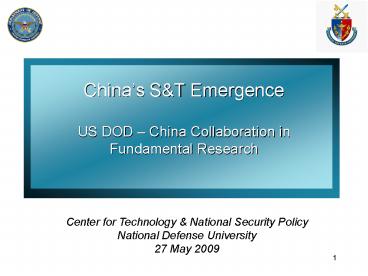Center for Technology - PowerPoint PPT Presentation
1 / 12
Title:
Center for Technology
Description:
Implemented a series of development plans aimed at guiding and modernizing the ... University of China (OUC) in Qingdao: regarded internationally as the premier ... – PowerPoint PPT presentation
Number of Views:48
Avg rating:3.0/5.0
Title: Center for Technology
1
Chinas ST Emergence US DOD China
Collaboration in Fundamental Research
Center for Technology National Security
Policy National Defense University 27 May 2009
2
ST Reform in China
- ST modernization began in 1949 with founding of
PRC. - Implemented a series of development plans aimed
at guiding and modernizing the countrys ST
capabilities. - Beginning in 1998, began to develop national
plans with a strong focus on innovation,
high-tech industry, and international
collaboration. - The driving forces behind Chinas most recent ST
advances have been - market-based reforms of Chinas ST
infrastructure - large supply of domestic ST research talent
- foreign capital investment from multinational
companies - technology transfer from foreign companies
- Chinese government investment in strategic
high-tech technologies.
3
Mid and Long-Range Plan for ST Development
(2006-2020)
- Plan lists 11 key fields, with 68
- priority subject areas
- Energy
- Water and mineral resources
- Environment
- Agriculture
- Manufacturing industry
- Transportation sector
- IT and modern service industries
- Population and health
- Urbanization and urban development
- Public safety
- National defense
- 8 categories of important, cutting-edge
- technologies
- Biotechnology
- IT
- New materials
- Advanced manufacturing
- Advanced energy
- Marine
- Laser
- Aerospace technologies
4
Mid and Long-Range Plan for ST Development
(2006-2020)
- Latest ST Plan aims for an RD expenditure of
2.5 percent of gross domestic product (GDP) by
2020. - China aims to become an innovation-oriented
country by 2020, ranking fifth in the world in
terms of the number of patents awarded to
nationals by 2020. - Goal Become a world leader in ST by 2050.
5
State of the Art in China
- In 2006, China surpassed Japan as worlds second
highest RD investor. - Total RD expenditures have risen from roughly
0.6 percent of GDP in 1995 to 1.5 percent in
2005, with total RD in 2006 equaling about 139
billion. - Key areas of funding energetic materials,
nanotechnology, biotechnology, IT, and materials
science.
6
Global ST
2
2
38
4
3
16
28
1
2
lt1
3
1
UIS ST database World Bank - PPP data
96
OECD 2008 PPP 2008Global RD Report (Battelle)
2
2
EU 24
30
12
18
3
1
4
lt1
3
1
World ST Investment - 1996 to 2007
7
Academia
- In 2004, China employed 2.25 million scientists
and engineers. - More than 6.5 million students were enrolled in
undergraduate science, medicine and engineering
programs in 2004, and more than half a million in
postgraduate science, medicine and engineering
programs 23,500 doctorates were awarded, 70
percent of them in science-related subjects. - In 2006, China published 8.4 percent of the
worlds scientific publications, second only to
the U.S.
8
Chinese Universities
- In a 2009 China University Review, top 5
academic Universities in China were - 1. Tsinghua University 2. Peking University
- 3. Zhejiang University 4. Shanghai Jiaotong
University - 5. Nanking University
- Top 5 Universities in Engineering were
- Tsinghua University
- Zhejiang University
- Shanghai Jiaotong University
- Harbin Institute of Technology
- Tianjin University
- Top 5 Universities in Physical sciences were
- Tsinghua University
- Zhejiang University
- Peking University
- Shanghai Jiaotong University
- Nanjing University
9
Research at Chinese Universities
- Peking University BioMEMS, computational
simulation on charge transport of semiconductor
and related modeling areas, silicon based
technology development. - The Ocean University of China (OUC) in Qingdao
regarded internationally as the premier
university in China for research in ocean
sciences. Strong programs of fundamental research
at OUC are in marine chemistry, ocean currents,
and remote sensing. - Zhejiang University top ranked university in
Mainland China for photonics research and also
has strong programs in meta-materials, optics and
electromagnetics. - Tsinghua University optoelectronics research,
hardware and software development for
communications, and nanotechnology.
10
Potential Areas of Collaboration
- Materials science, such as metamaterials and
catalysis - Molecular reaction dynamics
- Energetics
- Nanotechnology
- Biotechnology
- Brain and cognitive sciences
- Ocean sciences
- Information technology
- Energy and power technology
- Alternate and sustainable fuel technology
11
Why is Collaboration Important?
- Avoid technological surprise.
- Assists us in identifying and capitalizing on
emerging trends and technologies. - Allows us to leverage foreign resources and
capabilities. - Develops important relationships to enhance
national security.
12
Recommendations
- OSD(ATL) should encourage DOD and component
fundamental research scientists to engage in
collaborative fundamental research with top
Chinese academic research scientists in
scientific areas that will contribute to the DOD
Research Engineering Strategic Plan. - OSD(P) should develop a clear, streamlined, and
well-publicized process for OSD and Component
approval for fundamental research scientists to
visit Chinese academic institutions and to attend
ST conferences in China. - OSD(ATL), working with OSD(P) and the Services,
should develop a phased strategy for constructive
engagement in fundamental research with Chinese
academic institutions. - Specific recommendations are provided in
Chinas ST Emergence A Proposal for U.S.
DOD-China Collaboration in Fundamental Research,
available at - http//www.ndu.edu/ctnsp/Def_Tech/DTP204720Enga
ging20with20China.pdf































